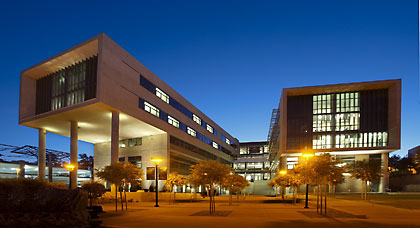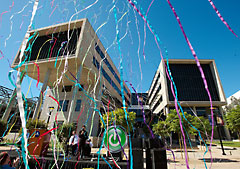

 Skip to navigation
Skip to navigation
Site Primary Navigation:
- About SDSC
- Services
- Support
- Research & Development
- Education & Training
- News & Events
Search The Site:

Published 10/14/2008
 Photo: Alan Decker |
Media Contacts:
Jan Zverina, SDSC Communications, 858 534-5111 or jzverina@sdsc.edu
Warren R. Froelich, SDSC Communications, 858 822-3622 or froelich@sdsc.edu
With the press of a large ‘I/O’ button and strobe lights simulating a “powering up” sequence, officials of the San Diego Supercomputer Center (SDSC) and University of California, San Diego ushered in the next era of data-intensive computing by dedicating a new, energy-efficient building extension as a key resource for UC San Diego and beyond.
 |
 |
| Photos: Alan Decker |
With five levels and two wings creating a V-shaped floorplan, the new structure doubles the size of the existing supercomputer center to 160,000 square-feet, while increasing SDSC’s overall machine room space to 18,000 square feet.
“This new building is much more than just concrete, steel, and glass,” said Berman, who has headed SDSC since 2001 and is a pioneer in grid supercomputing. “It’s about an exciting new world and SDSC’s potential to advance our partnerships within the University of California system, and more broadly, to advance the communities of research and education that benefit science and society as a whole.”
SDSC’s mission is to develop and promote ‘cyberinfrastructure’ -- an infrastructure that encompasses an open but organized aggregate of information technologies including computers, data archives, networks, software, digital instruments, and other scientific endeavors. The Center is also working to incorporate cyberinfrastructure into the overall academic infrastructure.
“Just as technology serves as the driver for the Industrial Age, cyberinfrastructure is the driver for the Information Age,” said Berman. “It will allow us to harness the technologies of the Information Age to create new knowledge and expand our efforts across the barriers of geography, time, and individual capability.”
“SDSC is an integral and essential part of the UC San Diego community, and it complements this university’s dedication and mission to extend its local impact, national influence and global reach,” said UC San Diego Chancellor Marye Anne Fox. “With this expansion, SDSC is poised to tackle the next generation of problems and challenges, and meet the critical need to manage data.”
“SDSC gives UC San Diego a level of cyber-expertise found on very few campuses anywhere in the world,” said Arthur Ellis, UC San Diego’s Vice Chancellor for Research. “SDSC is an essential resource that will help achieve our research goals at UC San Diego and the University of California, enabling us to advance society through innovation and discovery and to educate and train the next generation of leaders and citizens.”
“SDSC is truly a jewel in UC San Diego’s crown,” said Frieder Seible, Dean of UC San Diego’s Jacobs School of Engineering, noting that the supercomputer center has played an integral role in the engineering school and university being ranked among the best in the nation. “We need to evolve cyberinfrastructure to the point where we use it almost without thinking about it, and ensure that all our science and engineering researchers and students know how to leverage it to the fullest potential.”
Since being founded in 1985 through a grant from the National Science Foundation (NSF) as one of the original academic, national-level supercomputer centers, SDSC has earned a reputation as a top resource for data-intensive research and expertise, involved in a broad range of studies ranging from the inner working of the human body to the outer reaches of space. In the past year alone, SDSC was home to almost 120 funded projects, while participating as an integral partner in another 34 projects based elsewhere. The Center continues to work closely with the NSF on a wide scope of research initiatives, as well as collaborating with UC San Diego and the entire UC system on numerous projects.
SDSC also has more archival storage capacity than any other academic institution in the world, with capacity equal to about 25 petabytes (25 thousand trillion bytes), or about 1,000 times the digital plain-text equivalent of the printed collection in the Library of Congress. This capacity is in response to the ever-increasing amount of digital data, which, according to industry reports, could grow ten-fold between 2006 and 2011.
In addition to being the main data repository for TeraGrid, the nation’s largest open scientific discovery infrastructure linking compute resources among 11 partner sites across the U.S., SDSC is working in close collaboration with the UCSD Libraries on the development of long-term data preservation services for UC San Diego and beyond.
“SDSC is a great partner for the UCSD Libraries and UC San Diego, and is an important national resource,” said Brian E.C. Schottlaender, UCSD University Librarian. “The Center is a pioneer in data cyberinfrastructure and is helping to set the national agenda for stewardship and preservation of digital data assets.”
SDSC’s new building is also home to one of the first ‘OptIPortals,’ connected to the NSF TeraGrid via the ‘OptIPuter,’ an optical network device developed by UC San Diego’s California Institute for Telecommunications and Information Technology (Calit2). OptIPuter is widely viewed by high-performance supercomputing experts and users as a key step in creating a computer cyberinfrastructure, by allowing end-users to discover, reserve, and integrate remote computers, storage, and instruments.
The OptIPortal is already being used by Michael Norman, SDSC’s Chief Scientific Officer and UC San Diego professor of physics. Installed in Norman’s Laboratory for Computational Astrophysics at the new building, it is connected to Calit2 via the university’s optical complex, and is being used to visualize results from his cosmology simulations on the cutting edge petascale machines linked to SDSC through NSF’s TeraGrid. Norman plans to stage and analyze the terabytes of data generated at SDSC, using the campus optical fiber network.
“Advanced research tools such as the OptIPortal and OptIPuter, spearheaded by our research partners right here on campus, is a perfect example of the kind of close collaboration that will keep this university at the forefront of scientific research and education,” said Norman.
Award-Winning “Green” Building Design
The new building, designed by EHDD Architecture of San Francisco, incorporates innovative engineering approaches aimed at increasing the overall efficiency levels of data centers on UC campuses and elsewhere. In taking a leadership role in implementing energy-saving practices across the entire campus, UC San Diego was the first university to join The Green Grid, a global consortium of information technology companies dedicated to promoting energy-efficient data centers. SDSC is also a member of the Data Center Users Group and the Critical Facilities Round Table, among others.
Even before the new building was completed, its design was awarded the first LEED (Leadership in Energy and Environmental Design) Silver Certified equivalent project launched on the UC San Diego campus, because it will about 50 percent more efficiently than current California standards call for. The design also earned a Best Practices Award from the California Public Utilities Commission.
“We were thinking ‘green’ before the very first form was poured,” said Dallas Thornton, SDSC’s Division Director of Cyberinfrastructure Services. “Today, we are proud of the fact that as UC San Diego’s largest data center, this new building will be a living laboratory for efficiency initiatives to be used at other large data centers around the world.”
Key “green” highlights of the new SDSC building include:
These measures complement initiatives already in place at SDSC, including:
In addition to the computer machine room and specialized research laboratories for SDSC and other UC San Diego departments, the new building has several fully wired “collaboration spaces” on each floor where colleagues can confer. Additional facilities include 10 conference rooms, two classrooms, a large visualization lab, and a 200-seat auditorium that can be easily reconfigured into smaller spaces.
About SDSC
As an organized research unit of UC San Diego, SDSC is a national leader in creating and providing cyberinfrastructure for data-intensive research. Cyberinfrastructure refers to an accessible and integrated network of computer-based resources and expertise, focused on accelerating scientific inquiry and discovery. SDSC is a founding member of the national TeraGrid, which recently reached a combined compute capability equal to one petaflop (10^15 calculations per second).
San Diego Supercomputer Center (SDSC): www.sdsc.edu
California Institute for Telecommunications and Information Technology (Calit2): www.calit2.net
UC San Diego: www.ucsd.edu
TeraGrid: www.teragrid.org
National Science Foundation: www.nsf.gov